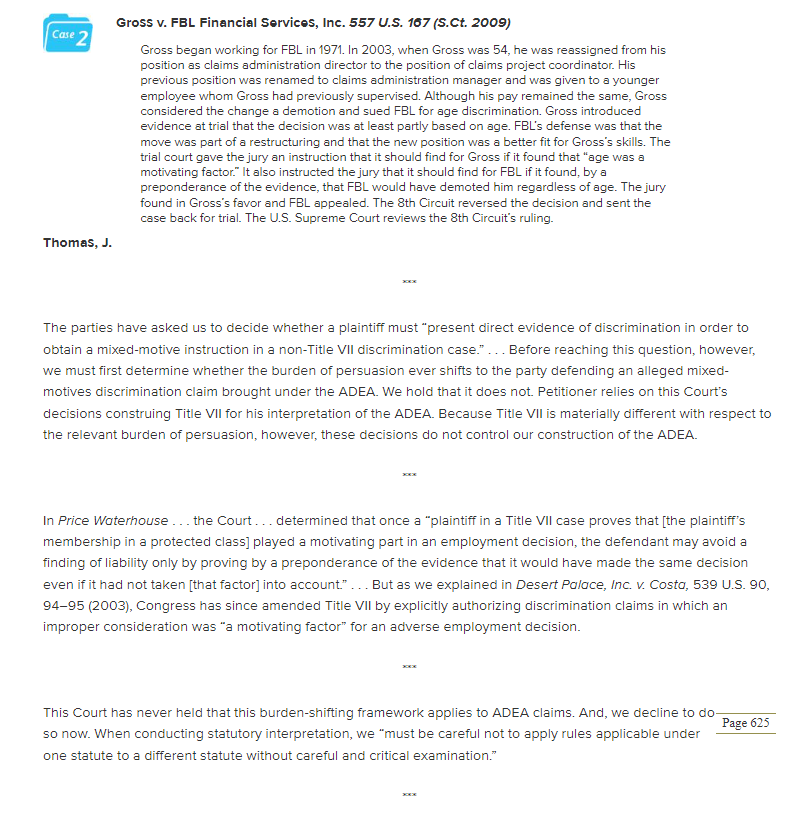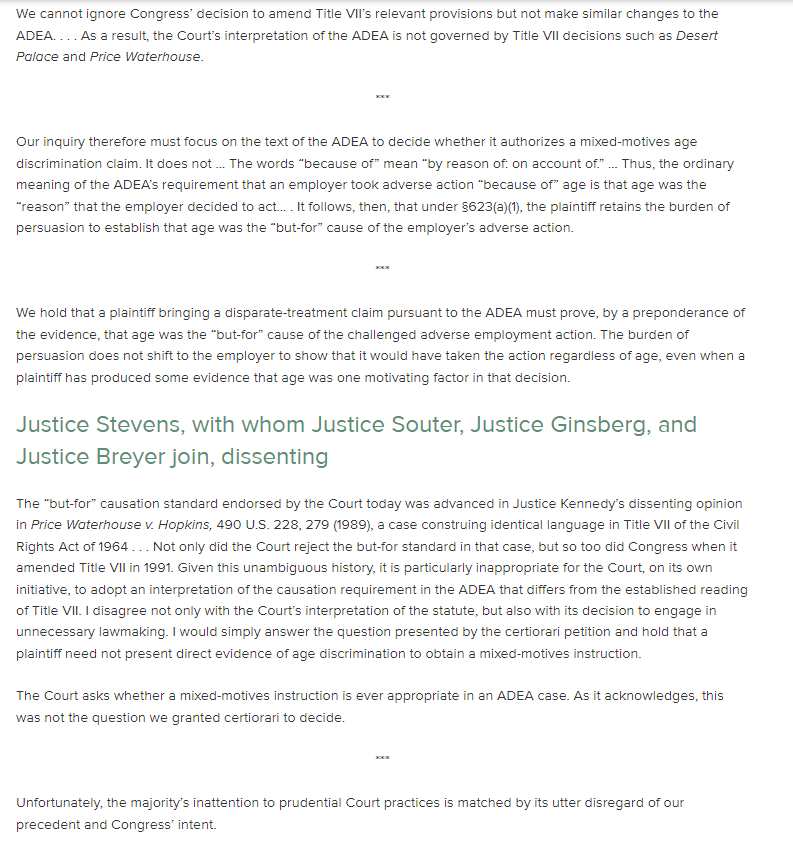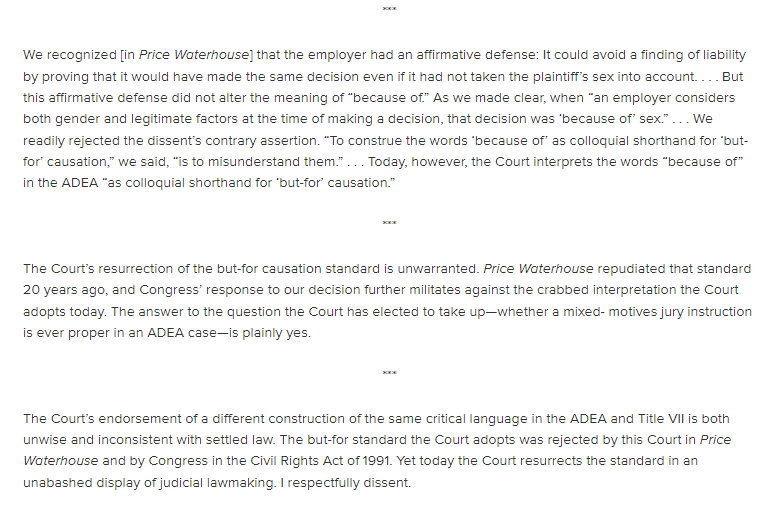


- In the Hazen case the Court attempts to settle a long-standing debate about age discrimination, whether seniority is a proxy (stand in) for age. Explain what the debate is about.
- Discuss your thoughts on elderly age restrictions for driving. What legal ground do you have to stand on?
Gross v. FBL Financial Services, Inc. 557 U.S. 167 (S.Ct. 2009) Gross began working for FBL in 1971. In 2003, when Gross was 54, he was reassigned from his position as claims administration director to the position of claims project coordinator. His previous position was renamed to claims administration manager and was given to a younger employee whom Gross had previously supervised. Although his pay remained the same, Gross considered the change a demotion and sued FBL for age discrimination. Gross introduced evidence at trial that the decision was at least partly based on age. FBL's defense was that the move was part of a restructuring and that the new position was a better fit for Gross's skills. The trial court gave the jury an instruction that it should find for Gross if it found that "age was a motivating factor." It also instructed the jury that it should find for FBL if it found, by a preponderance of the evidence, that FBL would have demoted him regardless of age. The jury found in Gross's favor and FBL appealed. The 8th Circuit reversed the decision and sent the case back for trial. The U.S. Supreme Court reviews the 8th Circuit's ruling. Thomas, J. The parties have asked us to decide whether a plaintiff must "present direct evidence of discrimination in order to obtain a mixed-motive instruction in a non-Title VII discrimination case." ... Before reaching this question, however, we must first determine whether the burden of persuasion ever shifts to the party defending an alleged mixedmotives discrimination claim brought under the ADEA. We hold that it does not. Petitioner relies on this Court's decisions construing Title VII for his interpretation of the ADEA. Because Title VII is materially different with respect to the relevant burden of persuasion, however, these decisions do not control our construction of the ADEA. In Price Waterhouse ... the Court ... determined that once a "plaintiff in a Title VII case proves that [the plaintiff's membership in a protected class] played a motivating part in an employment decision, the defendant may avoid a finding of liability only by proving by a preponderance of the evidence that it would have made the same decision even if it had not taken [that factor] into account." ... But as we explained in Desert Palace, Inc. v. Costa, 539 U.S. 90 , 94-95 (2003), Congress has since amended Title VII by explicitly authorizing discrimination claims in which an improper consideration was "a motivating factor" for an adverse employment decision. This Court has never held that this burden-shifting framework applies to ADEA claims. And, we decline to dc so now. When conducting statutory interpretation, we "must be careful not to apply rules applicable under one statute to a different statute without careful and critical examination." We cannot ignore Congress' decision to amend Title VIl's relevant provisions but not make similar changes to the ADEA. ... As a result, the Court's interpretation of the ADEA is not governed by Title VII decisions such as Desert Palace and Price Waterhouse. Our inquiry therefore must focus on the text of the ADEA to decide whether it authorizes a mixed-motives age discrimination claim. It does not ... The words "because of" mean "by reason of: on account of." ... Thus, the ordinary meaning of the ADEA's requirement that an employer took adverse action "because of" age is that age was the "reason" that the employer decided to act... . It follows, then, that under $623(a)(1), the plaintiff retains the burden of persuasion to establish that age was the "but-for" cause of the employer's adverse action. We hold that a plaintiff bringing a disparate-treatment claim pursuant to the ADEA must prove, by a preponderance of the evidence, that age was the "but-for" cause of the challenged adverse employment action. The burden of persuasion does not shift to the employer to show that it would have taken the action regardless of age, even when a plaintiff has produced some evidence that age was one motivating factor in that decision. Justice Stevens, with whom Justice Souter, Justice Ginsberg, and Justice Breyer join, dissenting The "but-for" causation standard endorsed by the Court today was advanced in Justice Kennedy's dissenting opinion in Price Waterhouse v. Hopkins, 490 U.S. 228, 279 (1989), a case construing identical language in Title VII of the Civil Rights Act of 1964 ... Not only did the Court reject the but-for standard in that case, but so too did Congress when it amended Title VII in 1991. Given this unambiguous history, it is particularly inappropriate for the Court, on its own initiative, to adopt an interpretation of the causation requirement in the ADEA that differs from the established reading of Title VII. I disagree not only with the Court's interpretation of the statute, but also with its decision to engage in unnecessary lawmaking. I would simply answer the question presented by the certiorari petition and hold that a plaintiff need not present direct evidence of age discrimination to obtain a mixed-motives instruction. The Court asks whether a mixed-motives instruction is ever appropriate in an ADEA case. As it acknowledges, this was not the question we granted certiorari to decide. Unfortunately, the majority's inattention to prudential Court practices is matched by its utter disregard of our precedent and Congress' intent. We recognized [in Price Waterhouse] that the employer had an affirmative defense: It could avoid a finding of liability by proving that it would have made the same decision even if it had not taken the plaintiff's sex into account. .. But. this affirmative defense did not alter the meaning of "because of." As we made clear, when "an employer considers both gender and legitimate factors at the time of making a decision, that decision was 'because of' sex." ... We readily rejected the dissent's contrary assertion. "To construe the words 'because of' as colloquial shorthand for "butfor' causation," we said, "is to misunderstand them." ... Today, however, the Court interprets the words "because of" in the ADEA "as colloquial shorthand for 'but-for' causation." The Court's resurrection of the but-for causation standard is unwarranted. Price Waterhouse repudiated that standard 20 years ago, and Congress' response to our decision further militates against the crabbed interpretation the Court adopts today. The answer to the question the Court has elected to take up-whether a mixed- motives jury instruction is ever proper in an ADEA case-is plainly yes. The Court's endorsement of a different construction of the same critical language in the ADEA and Title VII is both unwise and inconsistent with settled law. The but-for standard the Court adopts was rejected by this Court in Price Waterhouse and by Congress in the Civil Rights Act of 1991. Yet today the Court resurrects the standard in an unabashed display of judicial lawmaking. I respectfully dissent









